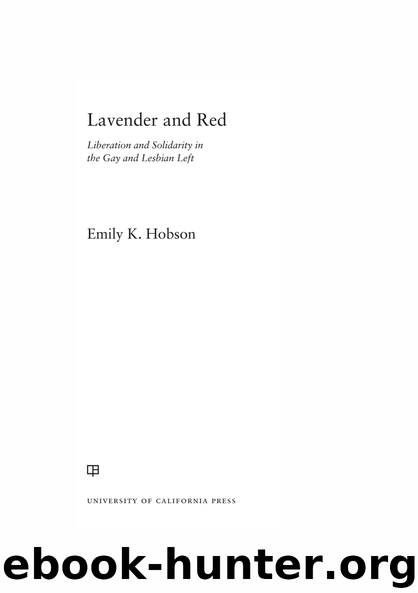Lavender and Red: Liberation and Solidarity in the Gay and Lesbian Left (American Crossroads) by Hobson Emily K

Author:Hobson, Emily K. [Hobson, Emily K.]
Language: eng
Format: epub
ISBN: 9780520279056
Publisher: University of California Press
Published: 2016-10-04T04:00:00+00:00
1. Massive funding to end the AIDS epidemic, made available from local, state and federal governments for research, care, education, anonymous testing programs and any and all treatments.
2. A federally funded education program which is comprehensive and sex positive, and which promotes safer sex, addiction recovery and IV hygiene.
3. Centrally coordinated research for AIDS treatments, cures and vaccines.
4. A free, nationalized health care system guaranteeing equal access, regardless of ability to pay.
5. Public accountability, especially to affected communities, regarding any AIDS-related research, funding and programs, to be controlled by the communities affected by AIDS.
6. A worldwide, culturally-sensitive funding program focused on ending the AIDS epidemic. The program would be initiated and financed by the United States, in cooperation with international health organizations. The U.S. would encourage the financial participation of other developed nations, with implementation controlled by the recipient nations.44
The last of these demands showed that AAP members understood the limits of a one-size-fits-all model of prevention and care that had been initiated to respond to white, largely middle-class gay men in the United States, who faced serious personal, social, and economic losses from AIDS but who were nonetheless more privileged than many in the expanding epidemic. Calls for “culturally-sensitive” programs pointed to activists’ awareness of new efforts both locally and internationally, including the Latino AIDS Project and the Nicaragua AIDS Education Project (chapter 5). The AAP’s demand for U.S. funding of a global AIDS program “controlled by the recipient nations,” as well as its demand that AIDS funding “be taken primarily from the military budget,” translated values from Central American solidarity and showed the group’s roots in the gay and lesbian left.
Like ACT UP, the AAP declined to define itself as an exclusively lesbian and gay group, seeking instead to recognize the impact of the epidemic across sexual identities. And although the AAP did not become the vehicle for queer sexual politics that ACT UP did, it paid significant attention to prostitutes’ rights thanks to the leadership of sex work organizer and AAP member Carol Leigh.45 The group also opposed quarantining, mandatory testing, discrimination against prisoners and undocumented immigrants with HIV/AIDS, and “inflammatory, isolating language” such as “AIDS blood” or “AIDS victim.”
The timing of the AAP’s formation connected it tightly to the October 1987 March on Washington for Lesbian and Gay Rights. Many Bay Area activists planned to travel to Washington, DC, especially to participate in a national gathering on AIDS direct action and a day of civil disobedience at the Supreme Court. Early AAP meetings revolved around planning for the Court action, with training led by “preparers,” people experienced in civil disobedience. Some of these sessions were held at the San Francisco Women’s Building, reinforcing connections to networks of Central American solidarity as well as to antinuclear activism.46 Kate Raphael led one such training with John Ashby, an HIV-positive member of the anti-militarist affinity group Enola Gay.47 Penn Garvin was another “preparer” who brought experience in the Pledge of Resistance and became a leader in the AAP. As
Download
This site does not store any files on its server. We only index and link to content provided by other sites. Please contact the content providers to delete copyright contents if any and email us, we'll remove relevant links or contents immediately.
| Anthropology | Archaeology |
| Philosophy | Politics & Government |
| Social Sciences | Sociology |
| Women's Studies |
The Secret History by Donna Tartt(18790)
The Social Justice Warrior Handbook by Lisa De Pasquale(12103)
Thirteen Reasons Why by Jay Asher(8761)
This Is How You Lose Her by Junot Diaz(6728)
Weapons of Math Destruction by Cathy O'Neil(6102)
Zero to One by Peter Thiel(5652)
Beartown by Fredrik Backman(5566)
The Myth of the Strong Leader by Archie Brown(5390)
The Fire Next Time by James Baldwin(5215)
How Democracies Die by Steven Levitsky & Daniel Ziblatt(5105)
Promise Me, Dad by Joe Biden(5054)
Stone's Rules by Roger Stone(5002)
100 Deadly Skills by Clint Emerson(4816)
A Higher Loyalty: Truth, Lies, and Leadership by James Comey(4813)
Rise and Kill First by Ronen Bergman(4670)
Secrecy World by Jake Bernstein(4611)
The David Icke Guide to the Global Conspiracy (and how to end it) by David Icke(4580)
The Farm by Tom Rob Smith(4412)
The Doomsday Machine by Daniel Ellsberg(4387)
